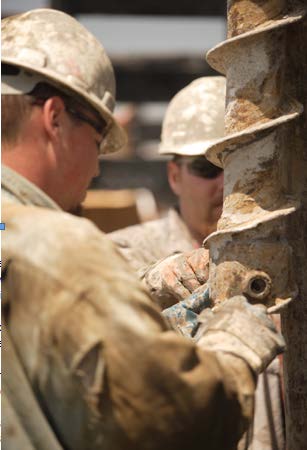Black River Sanitary Sewer StorageGeotechnical Investigations and Rock Tunnel Design
To reduce wet weather sanitary overflows into the Black River, the City of Lorain, Ohio identified several overflows to be captured and redirected to a storage facility during rain events. The city chose to construct a 6,000 lineal foot, 19-foot inside diameter rock tunnel along the west side of the Black River, a 30-foot diameter and112-foot deep drop shaft, and a 36-foot diameter and 176-foot deep submersible pump station. The deep tunnel concept provided a significant advantage over basin options because the community is able to utilize existing land along Lake Erie and the Black River for future development, and may be able to utilize the tunnel for future improvements to the city’s wastewater treatment facilities. Project Approach NTH was chosen by Malcolm Pirnie to provide geotechnical and tunnel engineering services, including a two-phase geotechnical and hydrogeologic investigation, design of the temporary and permanent liner systems for the tunnels and shafts, preparation of technical specifications, and opinions of probable construction costs. NTH assisted Malcolm Pirnie and the City of Lorain with initial route planning for the tunnel. Based largely on NTH’s advice and input from the city, the team chose an alignment which maximized the use of the city’s existing easements and eliminated crossings under the Black River. Malcolm Pirnie set an aggressive design schedule which allowed the city to apply for state and federal funding opportunities early in 2010. Extensive Field Investigation and Geotechnical Report Preparation NTH completed a two-phase geotechnical investigation which included over 900 lineal feet of soil drilling and 1,300 lineal feet of rock drilling. Inclined borings to intercept vertical fracture features in the bedrock were performed, along with in situ permeability tests using packer assemblies, an aquifer testing program, and a long-term groundwater level and explosive gas monitoring program. NTH performed nearly all soil and laboratory testing in our Cleveland laboratory facilities. Testing included Brazilian tensile strength, unconfined compressive strength, slake durability, Cerchar abrasity testing, and other standard soil and rock index tests. NTH prepared a geotechnical report which included the results of the tests, our interpretation of soil and rock behavior, and practical construction considerations, such as anticipated groundwater infiltration. Tunnel and Shaft Design While the field investigation was still underway, the NTH Tunnel Team began designing the primary and secondary lining systems for both the tunnel and the shaft structures. This project was particularly challenging due to the anticipated squeezing behavior of the Chagrin shales. The primary and secondary tunnel lining design consisted of steel ribs with timber lagging and reinforced cast-in place concrete, respectively. The shaft primary liner design consisted of a telescoping temporary earth retention system (TERS) with the upper TERS consisting of ribs with liner plate lagging and the lower TERS having rock bolts, wire mesh and shotcrete. The secondary liner design consisted of reinforced cast-in-place concrete. The project was released for bid in October 2011. |

